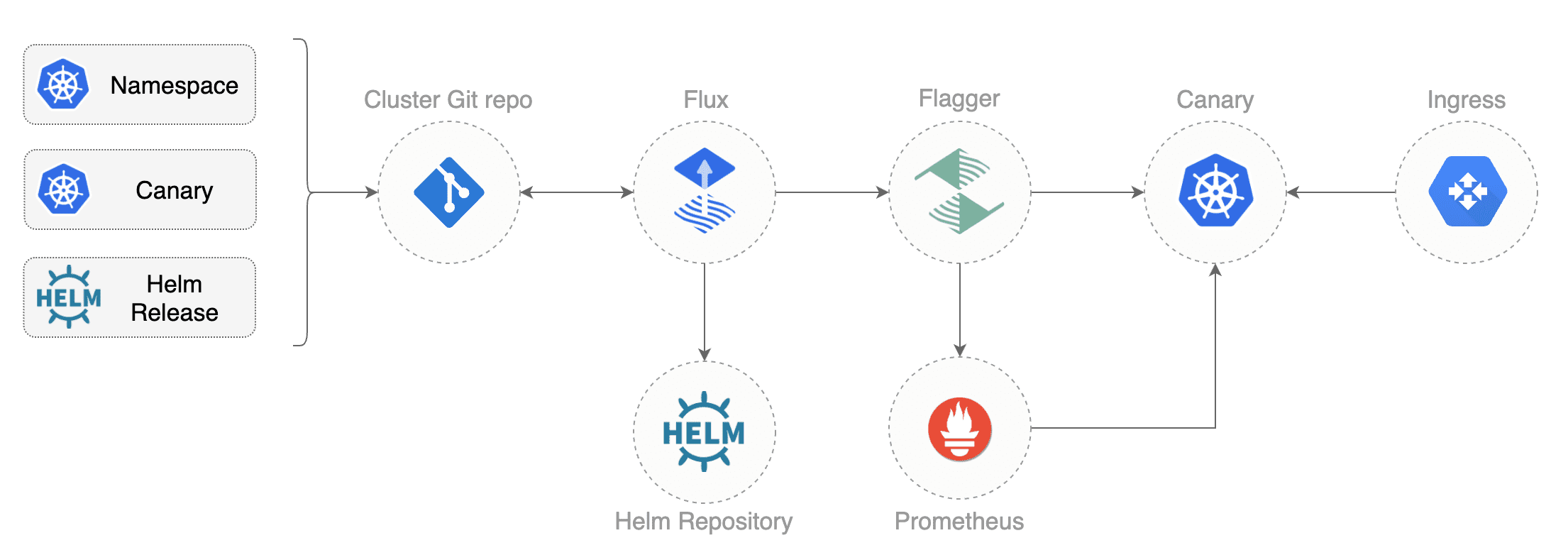This article is more than one year old. Older articles may contain outdated content. Check that the information in the page has not become incorrect since its publication.
January 2021 Update
Before we get started, what is GitOps?
If you are new to the community and GitOps, you might want to check out the GitOps manifesto or the official GitOps FAQ.
The Road to Flux v2
The Flux community has set itself very ambitious goals for version 2 and as it’s a multi-month project, we strive to inform you each month about what has already landed, new possibilities which are available for integration and where you can get involved. Read last month’s update here.
Let’s recap what happened in December - there have been many changes.
Flagger moves under the fluxcd organization

Flagger extends Flux functionality with progressive delivery strategies like Canary Releases, A/B Testing and Blue/Green and it was specifically designed for GitOps style delivery.
Since the inception of the GitOps Toolkit, it’s clear that fluxcd/ will
become more of a family of GitOps related projects. The Flagger
maintainers are looking forward to making use of the toolkit components
and simplifying Flagger this way. Consolidating the code-bases and
thinking in terms of a “Flux Family of Projects” and writing up the
roadmap accordingly should benefit both communities as a whole.
The two Flagger maintainers (Stefan Prodan and Takeshi Yoneda) are very happy to see this happening. Thanks also to Weaveworks for agreeing to transfer Flagger and its copyright to fluxcd org (and thus, CNCF).
Review the upcoming roadmap for Flagger - it now includes GitOps Toolkit integration.
Please help us steer this project forward!
Thanks also to everyone who contributed to the latest two releases:
- Flagger 1.6.0:
- Add support for A/B testing using Gloo Edge HTTP headers based routing
- Flagger 1.5.0:
- Flagger can be installed on multi-arch Kubernetes clusters (Linux AMD64/ARM64/ARM).
- The multi-arch image is available on GitHub Container Registry at ghcr.io/fluxcd/flagger.
Newest Flux v2 release: 0.5
🚀 🎁 We've released Flux2 v0.5, this is the last release for 2020.
Besides bug fixes and performance improvements, it comes with many new features. The highlights are:
- Alpha support for automated image updates to Git (thanks to Michael Bridgen - read more in the next paragraph)
- Support for Azure DevOps and the Git v2 protocol (thanks to Philip Laine - more below)
- Support for overriding container images in kustomize-controller (thanks to Somtochi Onyekwere)
- “flux bootstrap” and install commands can now be used on Windows OS without WSL (thanks to Hidde Beydals)
- flux can now be installed on Arch Linux using AUR packages (
flux-binorflux-gitfor the latest release) (thanks to Aurel Canciu)
Automated Image Updates
Automated Image Updates Guide (alpha release)
Flux v2 now includes two controllers for automating image updates -- one of the controllers is for scanning container image repositories, and the other updates and commits changes to YAML config, when there are new images to deploy.
These are the Flux v2 version of Flux’s automation, but work a little differently. The guide linked above explains how to set it up. Be aware that this is an alpha release for the image update automation controllers.
Azure DevOps repository support
Flux has not been able to support Azure DevOps repositories up until the 0.5 release. This was due to the git library go-git used by source-controller not supporting specific git capabilities required by Azure Devops. The same requirements do not exist in the other major git providers, which is why this was not caught during the initial development of source-controller.
This resulted in Flux v1 users who used Azure DevOps that were now not able to migrate to Flux v2. The initial attempt at a solution was to implement the missing capabilities in the existing library, which turned into its own epic. Instead the solution was to introduce a secondary git library libgit2 as it implements the required git capabilities. It turned out that libgit2 has its own limitations as it does not currently support shallow cloning, a feature that speeds up the git polling especially in very large git repositories. The compromise is to allow the user to choose which git library to use. The majority of users will be fine with the default original git library, while the Azure DevOps users will have to specify to use libgit2 in their GitRepository resources.
Follow the generic git server guide for further instructions in how to use Flux with Azure DevOps.
Upcoming events
- 11 Jan 2021 - Helm + GitOps ⚡ ⚡ ⚡ with Scott Rigby
In this session, Scott will go through the business value as well as the technical value for users + demo these benefits especially if you use Helm 3 with Flux 2.
In other news
The Flux community is growing and we are in the middle of a quite a few big discussions:
- We have a new guide which explains core concepts in the Flux world - please give feedback - and thanks Somtochi!
- Flux applies to upgrade to CNCF Incubation status: https://github.com/cncf/toc/pull/567
If you like what you read and would like to get involved, here are a few good ways to do that:
- Join our upcoming dev meeting on Jan 14
- Talk to us in the #flux channel on CNCF Slack
- Join the planning discussions
- And if you are completely new to Flux v2, take a look at our Get Started guide and give us feedback
- Social media: Follow Flux on Twitter, join the discussion in the Flux LinkedIn group
We are looking forward to working with you.